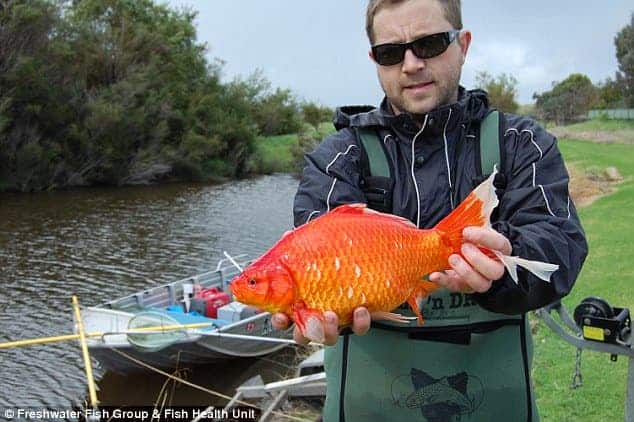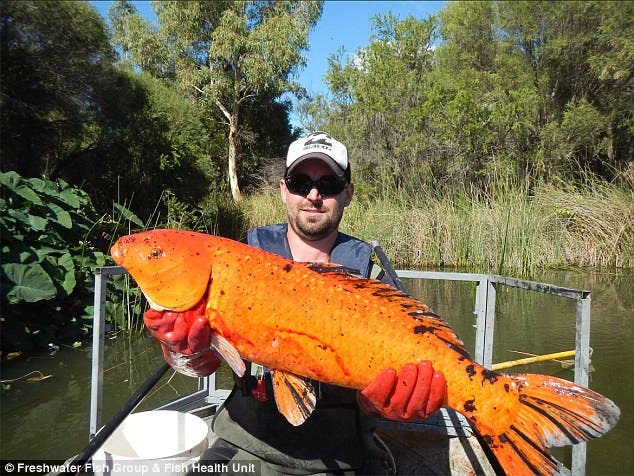They’re cute and don’t need too much taking-care-of as pets, but once released into the wild goldfish can wreak havoc on ecosystems — oh, and they grow huge. A team of Australian researchers reported finding wild goldfish that weigh up to 1.9 kg (4 pounds) in the Vasse River.

Image credits Jacy Ippolito / Flickr
Goldfish (Carassius auratus) were introduced in southwest Austraila’s Vasse River more than a decade ago, and over the past 12 years, there’s been a huge surge in their numbers. Far from being a natural event, the team says that the most likely cause of the invasion is pet owners. We brought them there, and now we need to understand exactly how the fish are impacting the environment. And it’s not looking good, as a team from Murdoch University, Perth, reports.
“Perhaps they were kids’ pets where the family have been moving house and their parents, not wanting to take the aquarium, have dumped them in the local wetlands,” lead researcher Stephen Beatty from Murdoch University in Perth, said for ABC News.
“Unfortunately a lot of people don’t understand that wetlands connect up to river systems and introduced fish, once they get in there, can do a lot of damage to native freshwater fish and the aquatic habitat.”
The team tagged and followed 15 wild goldfish near Busselton, in the Vasse River, over 12 months. They found that the fish move much farther than previously believed, swimming all the way to a wetland system to spawn throughout the year.
“Our research discovered the fish displayed a significant seasonal shift in habitats during breeding season, with one fish moving over 230 kilometres during the year,” said Beatty.
But they’re just goldfish, right? Those little things that swim around in the aquarium, nibbling at a fake seaweed if they’re particularly adventurous. What’s so wrong with having them in a river? Well for starters, they’re the goldfish of your nightmares — they grow as large as available resources will allow them.

“Available resources” here meaning other sea creatures as goldfish are carnivorous, putting a huge strain on native species. Not only that, but the way they go about feeding is particularly damaging to the ecosystem.
“They cruise along the bottom stirring up the substrate with their feeding strategy, this can re-suspend nutrients into the water column which exacerbates things like algal blooms,” said Beatty. “They can also disrupt aquatic plants and eat other fish’s eggs.”
The team also suspects that goldfish have introduced at least one new disease to the river already, and are directly responsible for a decline in the number of native fish.
The main thing to take away from this is: don’t dump your goldfish in the local waterways! This isn’t a problem only in Australia. Last year, Colorado Parks and Wildlife officials reported that a lake in Boulder County, U.S., was infested with around 3,000 koi carps, who spawned there after an owner dumped just a few fish in a waterway nearby. Lake Tahoe in California has similarly been infested. Canadian authorities also put out a plea last year to stop pet owners from dumping their goldfish, saying that the species is now taking over many lakes and ponds, and pushing out native species.

But Beatty’s team findings could help us develop strategies to try and stop the goldfishes’ spread on the Vasse River, even remove them altogether. And the data from Australia could be used to do so in all those other places that are going through the same problem.
But in the meantime, and I can’t stress this enough, don’t dump your goldfish into the wild. Having a pet is a responsibility that you can’t shrug from just because it’s not convenient — if you do, that cute little goldfish will grow into an environmental 4-pound nightmare.
The full paper, “First evidence of spawning migration by goldfish (Carassius auratus); implications for control of a globally invasive species” has been published in the journal Ecology of Freshwater Fish.


